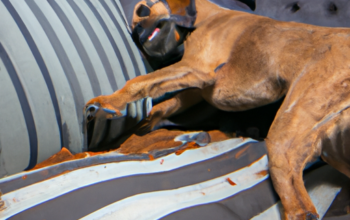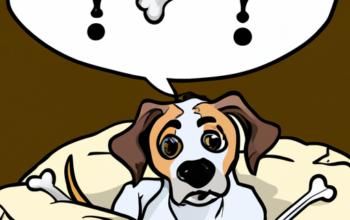You’ve probably never met a creature as expressive as your four-legged furry friend. They can’t use words to communicate, and yet, they manage to convey their feelings perfectly. How do they achieve this feat? Primarily through tail wagging! This seemingly simple gesture is actually a complex form of communication that dogs use to express everything from joy to nervousness, fear or even aggression.
In this article, we’ll delve into the fascinating world of canine communication, breaking down different wagging patterns and what they mean. We’ll explore how dogs display emotions through movement and distinguish between signs of happiness and aggression. By the end of this read, you’ll understand your pet’s non-verbal cues better than ever before.
So get ready for an enriching journey into understanding why dogs wag their tails – it’s much more than just a simple shake of the rear end!
Understanding Canine Communication
You’ve got to understand, dogs aren’t just wagging their tails for fun, it’s a vital part of their communication toolkit. It’s an extension of their emotions and intentions.
Tail wagging is one aspect of canine body posture that indicates various feelings such as happiness, agitation, or fear.
Let’s delve into the ‘Tail Tucking Significance’. When your dog tucks its tail between its legs, it’s usually a sign of fear or submission. This posture is often observed in uncertain and stressful situations.
On the contrary, when they’re excited or happy to see you, they express it with vigorous tail wagging.
Understanding these subtle cues in canine body posture can deepen your bond with your furry friend and help prevent misunderstandings. Remember, every wag has a story to tell!
Displaying Emotions Through Movement
Interestingly, about 70% of a canine’s communication is conveyed through body language, and the swaying movement of their posterior extension is one significant way they express emotions. A dog’s tail vocabulary can speak volumes about what they’re feeling.
A rapid wagging motion generally indicates happiness or excitement. However, a slow, stiff wag might signify caution or uncertainty. The height at which your dog holds its tail also plays a part in emotion identification. If held high it shows dominance and confidence. Conversely, a low-held tail typically suggests fear or submission.
Remember that not all breeds express emotions the same way with their tails due to physical differences. Hence, understanding your specific breed’s tail talk will ensure smoother communication and stronger bonds with your four-legged friend.
Aggression Versus Happiness
Canine behavior is a fascinating subject, isn’t it? Let’s delve into the subtle difference between aggression and happiness in your furry friend.
A wagging tail doesn’t always mean they’re happy. Sometimes, it can signal aggression or fear. If their tail is high and rigid while wagging, your dog might be on edge.
Tail biting could be a sign of discomfort or agitation too. Dogs usually resort to this when they’re extremely stressed or anxious.
On the flip side, a relaxed wagging tail generally indicates contentment.
Playful snarling also shouldn’t worry you; dogs often do this when they’re engaged in play. However, if the snarl becomes intense and paired with aggressive body language, that’s a different story entirely!
Understanding these nuances can help ensure harmonious coexistence with our four-legged companions.
Non-Verbal Communication in Canines
Observing your furry friend’s body language is akin to learning a foreign language, where actions speak louder than barks. Just like humans, dogs communicate through non-verbal signals or ‘Canine Sign Language’. The wag of their tail is an essential part of this sophisticated sensory perception.
-
Direction: The direction in which your dog wags his tail provides information about their emotional state. A wag to the right generally means happiness and confidence; a wag to the left indicates nervousness or uncertainty.
-
Speed: Fast wagging indicates high energy and often excitement, while slow wags might mean your dog is relaxed but alert.
-
Movement Pattern: Broad wags are friendly and welcoming, whereas slight wags could indicate insecurity or fear.
Understanding these subtle cues can significantly enhance your bond with your beloved pet.
Interpreting Different Wagging Patterns
Delving into the intricate language of tail wags can be a truly heartwarming experience, as it opens up a new level of understanding and connection between you and your furry best friend. A dog’s wagging speed and tail positioning can tell you a lot about their emotions at that moment.
A fast-paced wag often signifies excitement or happiness, while slower wags might indicate uncertainty or caution. The height of the tail also matters. A high-positioned tail typically shows dominance or agitation, whereas a lower one can imply submission or fear. When your dog’s tail is relaxed and wagging in its natural position, it usually means they’re contented.
Understanding these different wagging patterns allows for better communication with your pet, enhancing your bond even further.
Frequently Asked Questions
How does a dog’s breed affect the way it wags its tail?”
“Breed specific communication and tail wagging genetics can impact how a dog wags its tail. Certain breeds have unique ways of expressing emotions through their tails, making each wag nuanced and distinct.”
Can a dog’s age or health condition influence its tail wagging?”
Just like your moods sway with age and health, a dog’s tail wagging can too. Tail injuries or health conditions may limit movement, impacting the emotional display. Aging dogs might also wag less due to reduced energy.
Do dogs wag their tails when they are alone or is it only in response to other beings?”
Dogs’ wagging patterns can change based on their environment. Tail communication is not solely for other beings; dogs often wag their tails even when alone, expressing various emotions or a response to stimuli.
Does the speed of the tail wagging indicate different meanings?”
Yes, the speed of tail wagging does indicate different meanings. Wagging rhythms and tail posture both play a role in canine communication. A fast wag can signal excitement while a slow wag might show uncertainty.
Can a dog’s tail wagging serve any physical functions, like maintaining balance?”
Like a tightrope walker’s pole, dogs’ wagging patterns can aid in balance. However, tail injuries may hinder this function. So yes, besides communication, a dog’s tail wagging serves physical functions too.
Conclusion
So, like a book that’s open for you to read, a dog’s tail can tell many stories. It’s essential for you to understand your furry friend’s language of wags and twitches. Remember, not every wag is friendly. By learning to interpret their tail movements, you’ll be able to communicate better and build an even stronger bond with your canine companion.



